Imitation of Peers in Children and Adults
Abstract
:1. Introduction
1.1. Related Literature
2. Experimental Design
3. Results
4. Conclusions
Acknowledgments
Author Contributions
Conflicts of Interest
Appendix A. Supplementary Material
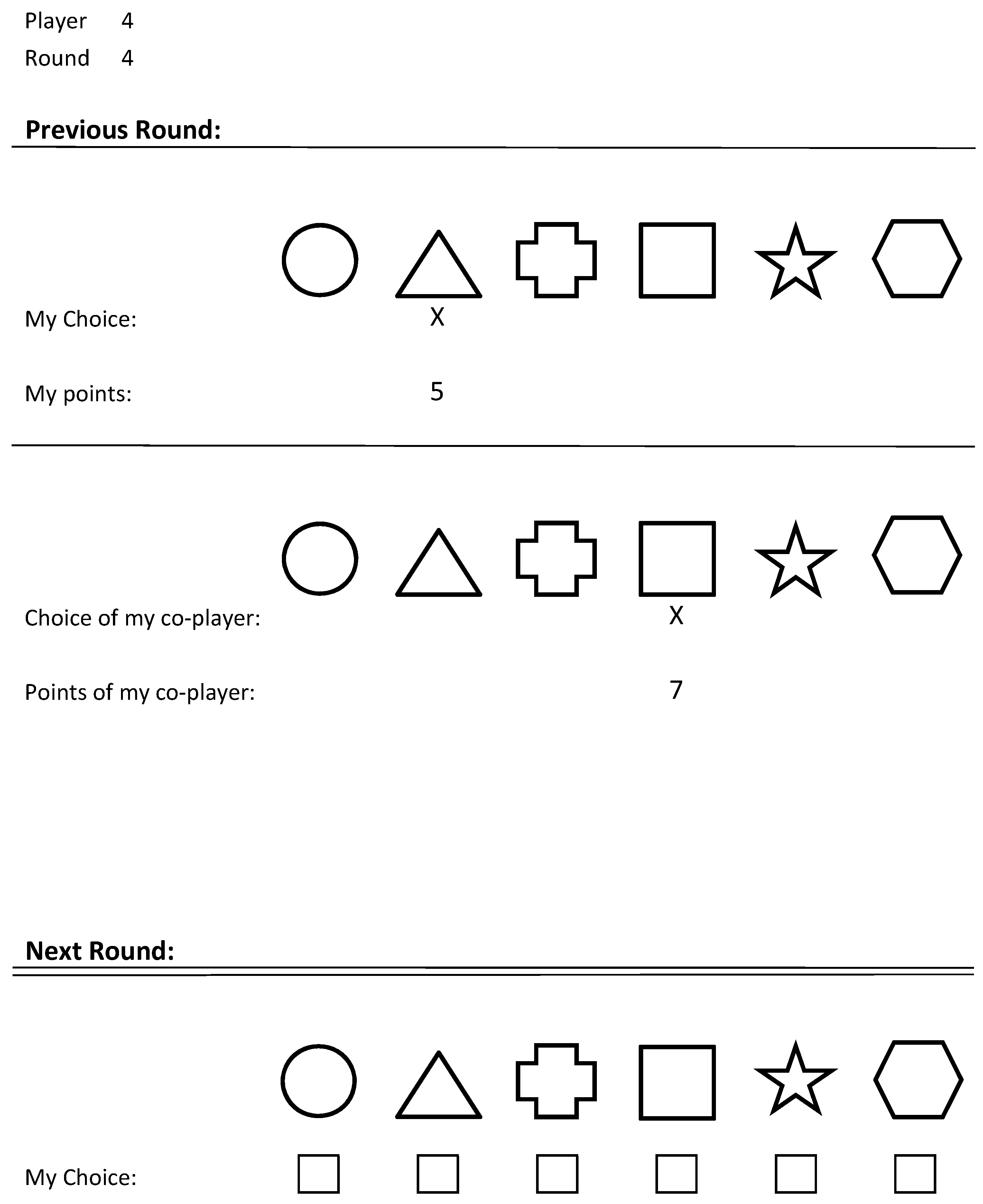

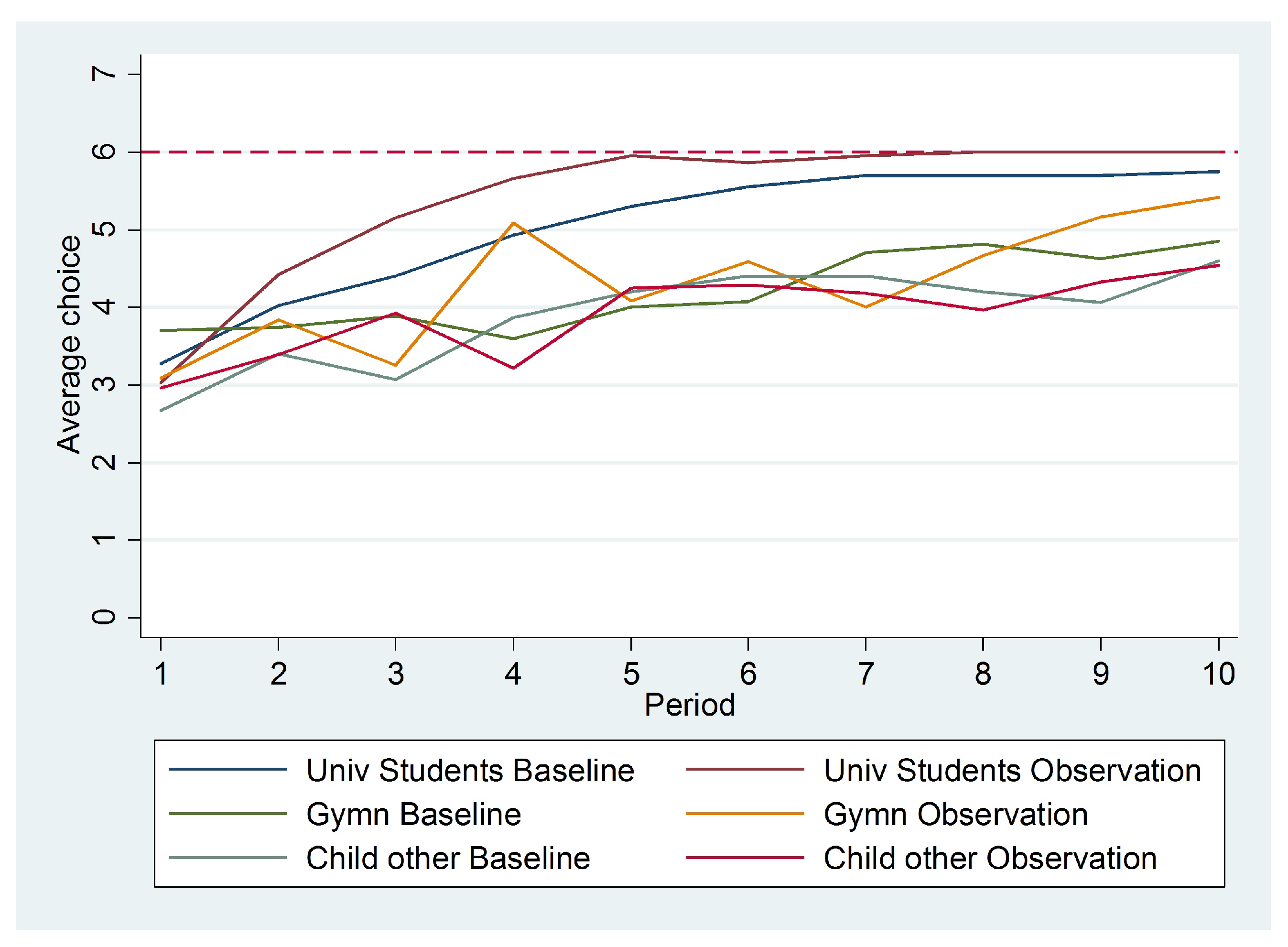
| Children | University Students | |||
|---|---|---|---|---|
| Baseline | Observation | Baseline | Observation | |
| Period | 0.16 *** | 0.16 *** | 0.26 *** | 0.26 *** |
| Constant | 3.21 *** | 3.13 *** | 3.60 *** | 3.98 *** |
| N | 420 | 400 | 400 | 380 |
Appendix B. Instructions
- There are six urns in our game (point at the urns on the blackboard).
- There are two balls in each of these urns (point at the balls in the urns on the blackboard).
- Inside one of these urns there is a ball worth one point and a ball that gives you two points (label the balls in one of the urns on the blackboard with numbers one and two).
- Inside another one of these urns there is a ball worth two points and a ball that gives you three points (label the balls in one of the urns on the blackboard with numbers two and three).
- Inside a further one of these urns there is a ball worth three points and a ball that gives you four points (label the balls in one of the urns on the blackboard with numbers three and four).
- Inside another one of these urns there is a ball worth four points and a ball that gives you five points (label the balls in one of the urns on the blackboard with numbers four and five).
- Inside one of these urns there is a ball worth five points and a ball that gives you six points (label the balls in one of the urns on the blackboard with numbers five and six).
- Inside another one of these urns there is a ball worth six points and a ball that gives you seven points (label the balls in one of the urns on the blackboard with numbers six and seven).
- Your task in each period is to choose one of the urns.
- After you’ve chosen one of the urns the computer is going to draw one of the balls inside the urn at random and you will get the points stated on that ball.
- You can think of the game as follows. Here are six urns.
- If you, for example, decide to choose the red urn, then the computer will compute your points as if it would randomly draw a ball out of this urn (draw a ball out of the red bowl with covered eyes and show the ball with its associated number to the kids). After having drawn the ball and after having allocated the associated points to you, the computer will put the ball back into the same urn and the next period of the game will be about to begin (put the ball back into the bowl).
- If you decide to choose the blue urn in the next period, then the computer will draw a ball out of the blue urn. You get the points that are written on this ball, and the ball will be placed back into the urn (draw a ball with covered eyes out of the blue bowl, show the ball with its associated number to the kids, and put the ball back into the bowl).
- If you decide to choose the blue urn again in the next period, then the computer will again draw one of the two balls. You get the points that are written on this ball and the ball will be placed back into the urn (again, draw a ball out of the blue bowl with covered eyes, show the ball with its associated number to the kids, and put the ball back into the bowl).
- However, the urns in our game will not be differentiated by colors. But each urn will be associated with a sign. We have one urn marked with a circle (point to the circle on the blackboard), one urn with a square (point to the square on the blackboard), one urn with a triangle (point to the triangle on the blackboard), one urn with a cross (point to the cross on the blackboard), one urn with a star (point to the star on the blackboard) and one urn with a hexagon (point to the hexagon on the blackboard). The urns will have the same sign throughout the whole game. But we will not tell you which sign belongs to which urn.
- What you know is that there is one urn with a ball labeled 1 and a ball labeled 2. There is one urn with a ball labeled 2 and a ball labeled 3. In one urn there is a ball labeled 3 and a ball labeled 4. In one urn there is a ball labeled 4 and a ball labeled 5. In one urn there is a ball labeled 5 and a ball labeled 6 and in one urn there is a ball labeled 6 and a ball labeled 7.
- In order for you to decide on one urn and to get to know how many points you’ve earned with one of the urn’s balls, we will provide you with a decision sheet at the beginning of each period (show a period 1 decision sheet).
- On top of the sheet you will find your unique player’s number, which lets the computer know who you are and you will find the period in which we’re currently in.
- Underneath you will see the six signs of the urns. In each period your task is going to be to decide on one of the signs. As soon as you’ve decided on one of the signs, you tick off the box underneath the sign and wait for us to collect your decision sheet.
- From the second period on, you will find some more information on your decision sheet. On top of the sheet you will again find your player’s number and the current period (show a period 2 decision sheet).
- Underneath, you will see what happened in the previous period.
- You can see what urn you did choose. The sheet tells you “my choice” and shows you a ticked off box underneath your previous period’s sign.
- You can have a look on how many points you did get with your choice. The sheet says “my points”.
- Underneath, you will again find the six signs of the urns and you can again decide on an urn’s sign.
- [Only in the Observation treatment: Additionally, we will tell you what one of the other kids in class who plays the exact same game as you do chose to do in the previous period and how many points this kid earned with her choice.]
- The game will last 10 periods. We will tell you when the last period is going to be.
- The important thing is that you understand that different urns can give you different numbers of points.
References
- Alós-Ferrer, C.; Schlag, K. Imitation and Learning. In The Handbook of Rational and Social Choice; Anand, P., Pattanaik, P., Puppe, C., Eds.; Oxford University Press: Oxford, UK, 2009. [Google Scholar]
- Offerman, T.; Schotter, A. Imitation and luck: An experimental study on social sampling. Games Econ. Behav. 2009, 65, 461–502. [Google Scholar] [CrossRef]
- Vega-Redondo, F. The Evolution of Walrasian Behavior. Econometrica 1997, 65, 375–384. [Google Scholar] [CrossRef]
- Bandura, A. Social Learning Theory; General Learning Press: New York, NY, USA, 1971. [Google Scholar]
- Asch, S. Social Psychology; Prentice Hall: Englewood Cliffs, NJ, USA, 1952. [Google Scholar]
- Ray, E.; Heyes, C. Imitation in infancy: The wealth of the stimulus. Dev. Sci. 2011, 14, 92–105. [Google Scholar] [CrossRef] [PubMed]
- Meltzoff, A.N. Infant imitation after a 1-week delay: Long-term memory for novel acts and multiple stimuli. Dev. Psychol. 1988, 24, 470. [Google Scholar] [CrossRef] [PubMed]
- Gergely, G.; Bekkering, H.; Király, I. Developmental psychology: Rational imitation in preverbal infants. Nature 2002, 415, 755. [Google Scholar] [CrossRef] [PubMed]
- Hanna, E.; Meltzoff, A.N. Peer imitation by toddlers in laboratory, home, and day-care contexts: Implications for social learning and memory. Dev. Psychol. 1993, 29, 701. [Google Scholar] [CrossRef] [PubMed]
- Zmyj, N.; Seehagen, S. The role of a model’s age for young children’s imitation: A research review. Infant Child Dev. 2013, 22, 622–641. [Google Scholar] [CrossRef]
- Huck, S.; Normann, H.T.; Oechssler, J. Learning in Cournot Oligopoly—An Experiment. Econ. J. 1999, 109, C80–C95. [Google Scholar] [CrossRef]
- Offerman, T.; Potters, J.; Sonnemans, J. Imitation and Belief Learning in an Oligopoly Experiment. Rev. Econ. Stud. 2002, 69, 973–997. [Google Scholar] [CrossRef]
- Apesteguia, J.; Huck, S.; Oechssler, J. Imitation—Theory and experimental evidence. J. Econ. Theory 2007, 136, 217–235. [Google Scholar] [CrossRef] [Green Version]
- Harbaugh, W.T.; Krause, K.; Vesterlund, L. Learning to bargain. J. Econ. Psychol. 2007, 28, 127–142. [Google Scholar] [CrossRef]
- Fehr, E.; Bernhard, H.; Rockenbach, B. Egalitarianism in young children. Nature 2008, 454, 1079–1083. [Google Scholar] [CrossRef] [PubMed] [Green Version]
- Almås, I.; Cappelen, A.W.; Sørensen, E.Ø.; Tungodden, B. Fairness and the development of inequality acceptance. Science 2010, 328, 1176–1178. [Google Scholar]
- Sutter, M.; Kocher, M.G.; Glätzle-Rützler, D.; Trautmann, S.T. Impatience and uncertainty: Experimental decisions predict adolescents’ field behavior. Am. Econ. Rev. 2013, 103, 510–531. [Google Scholar] [CrossRef] [Green Version]
- Lergetporer, P.; Angerer, S.; Glätzle-Rützler, D.; Sutter, M. Third-party punishment increases cooperation in children through (misaligned) expectations and conditional cooperation. Proc. Natl. Acad. Sci. USA 2014, 111, 6916–6921. [Google Scholar] [CrossRef] [PubMed]
- Sher, I.; Koenig, M.; Rustichini, A. Children’s strategic theory of mind. Proc. Natl. Acad. Sci. USA 2014, 111, 13307–13312. [Google Scholar] [CrossRef] [PubMed]
- Alós-Ferrer, C.; Weidenholzer, S. Imitation and the role of information in overcoming coordination failures. Games Econ. Behav. 2014, 87, 397–411. [Google Scholar] [CrossRef]
| 1. | See Alós-Ferrer and Schlag [1] for a broad review. |
| 2. | |
| 3. | In fact, one would have to assume a particular utility function to solve the problem. Even then, it is extremely tedious, although possible, to solve the problem via backward induction. |
| 4. | For non-parametric tests, we considered the average choice of one subject (in the Baseline treatment) or one pair of subjects (in the Observation treatment) as one independent observation. |
| 5. | Moreover, we did not find a treatment effect for any of the questions contained in the children’s questionnaire. |
| 6. | Differentiating between “Gymnasium” and “non-Gymnasium” children does not change much (see Figure A3 in Appendix A). |
| 7. | Random effect regressions with clustered standard errors and a period variable (reported in Table A1 in the Appendix A) show that average choices for all groups in Figure 3 display a significant upward trend. |
| 8. | |
| 9. | We could also define errors more broadly by assuming that subjects memorize outcomes of pervious rounds. However, this would assume that we know how long the memory of the subject is and would complicate the analysis substantially. |
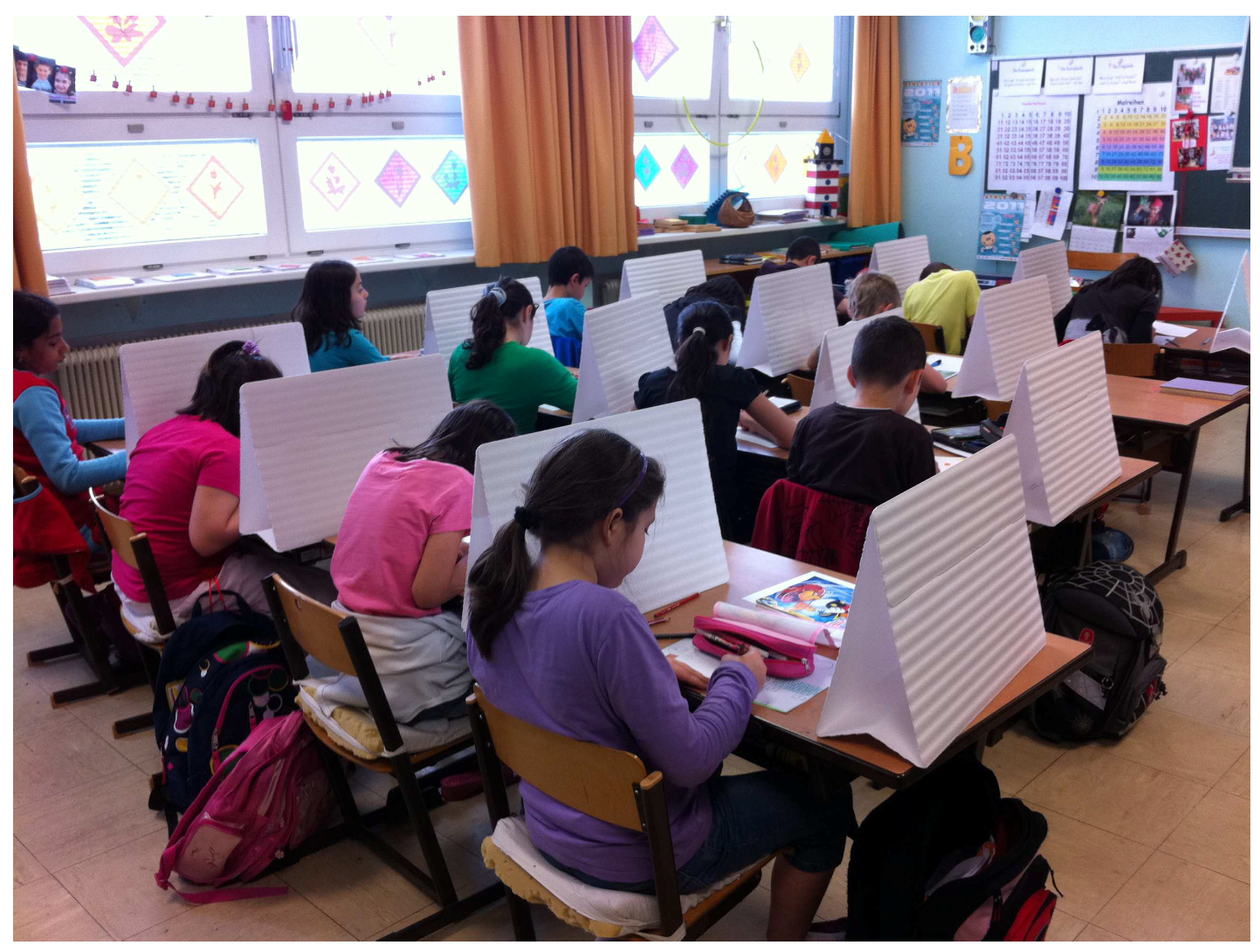
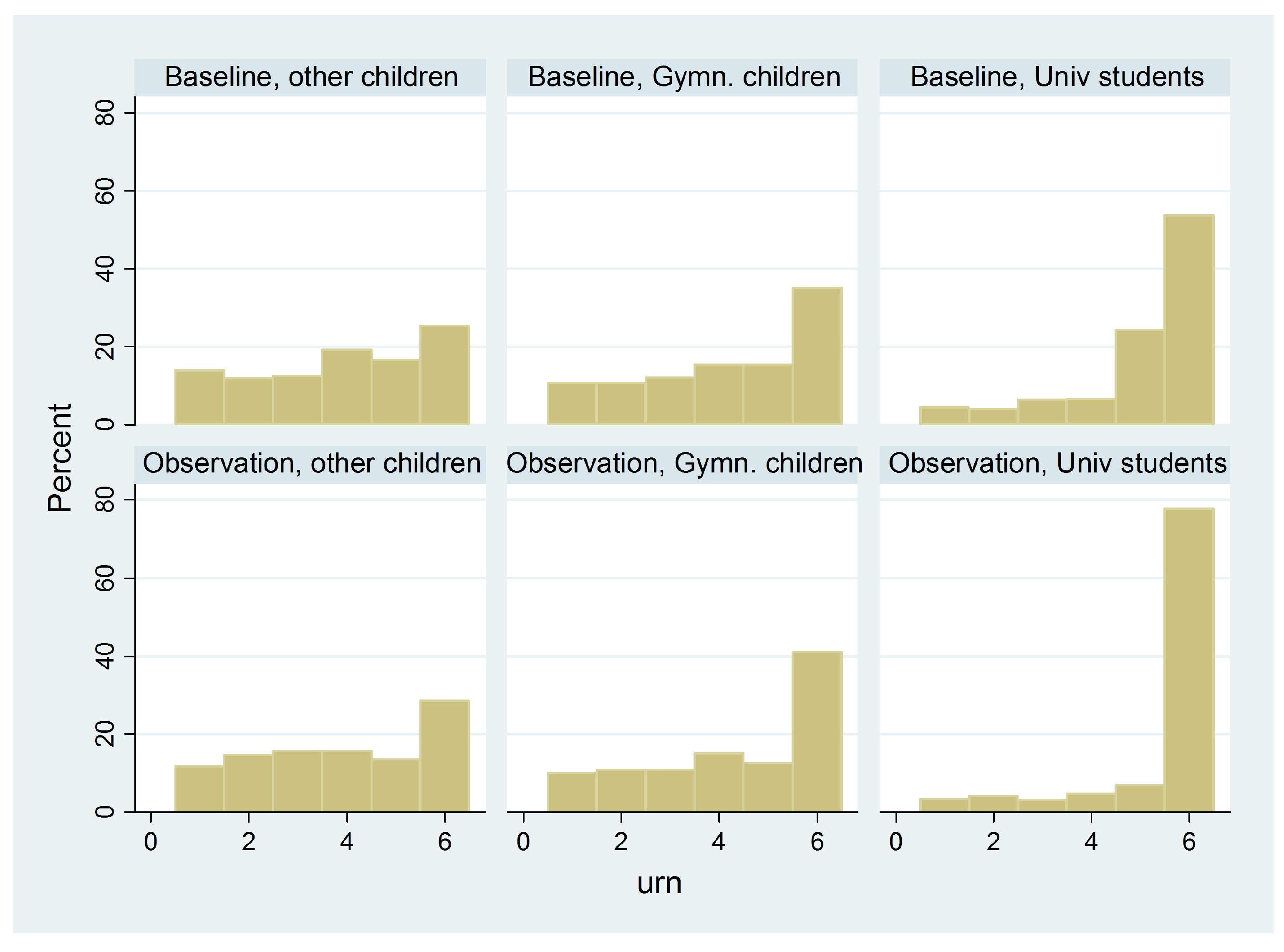
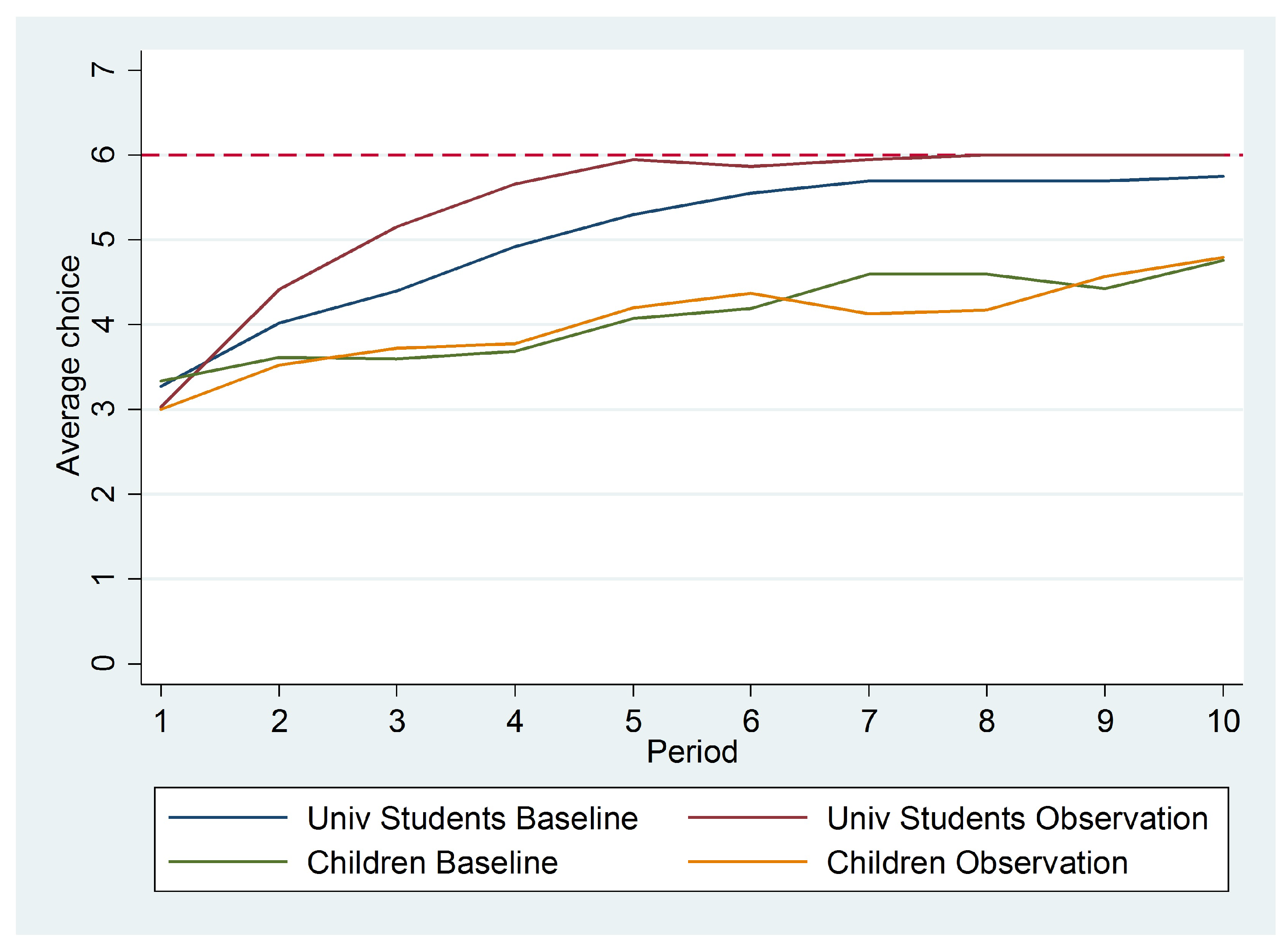
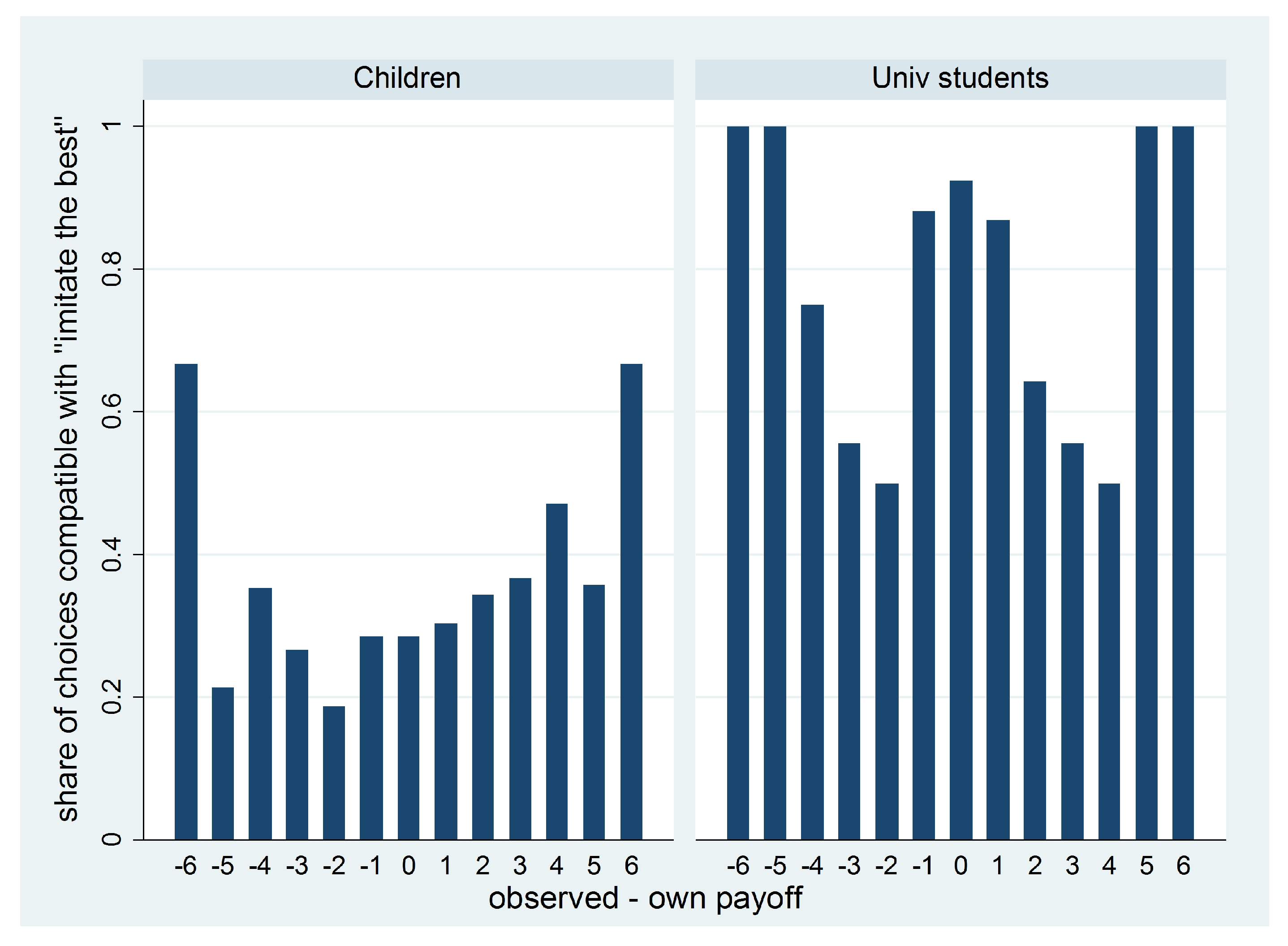
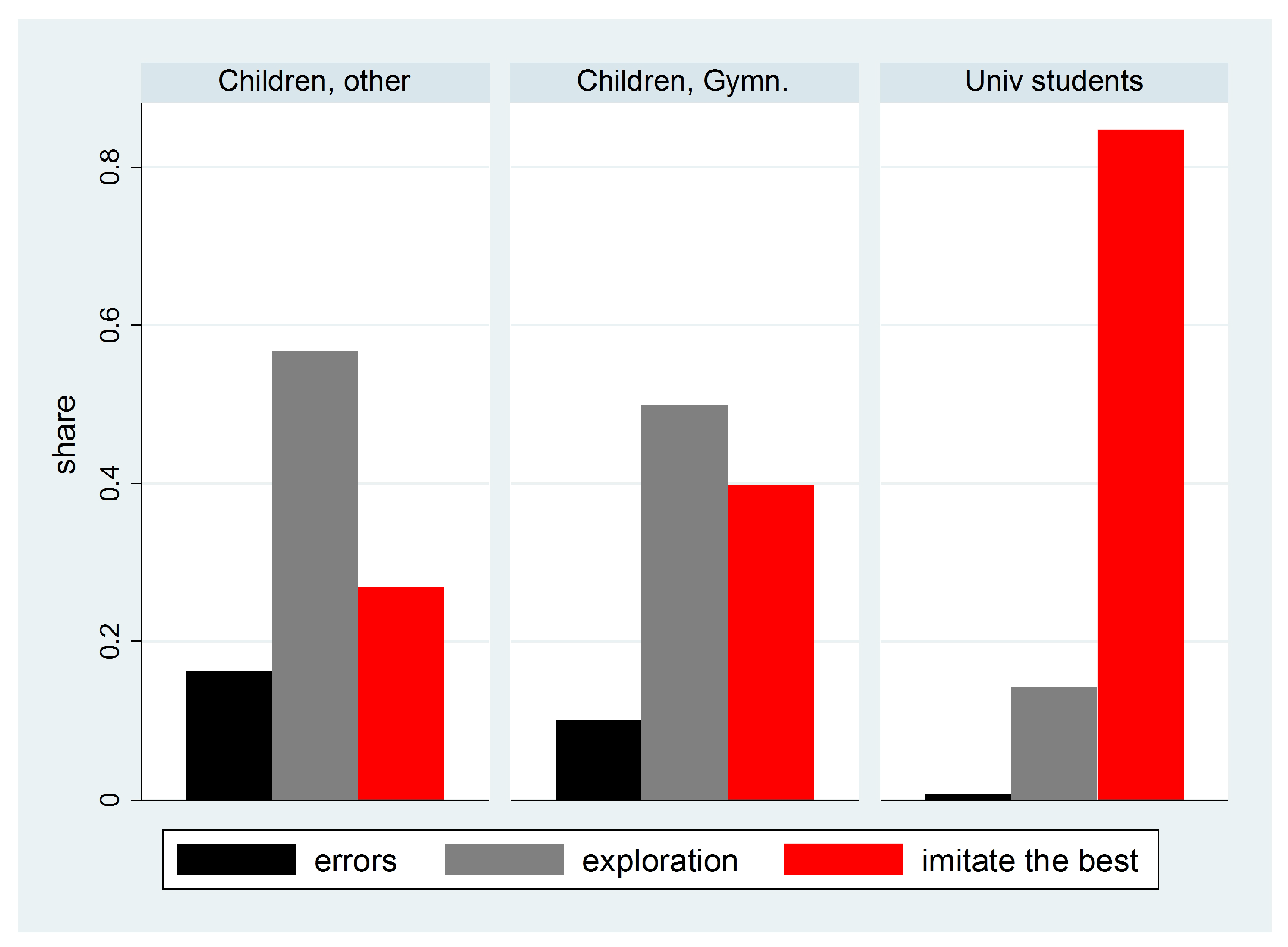

| Children | University Students | |||||
|---|---|---|---|---|---|---|
| “Gymnasium” | Other | |||||
| Baseline | Observation | Baseline | Observation | Baseline | Observation | |
| mean | 4.20 | 4.32 | 3.89 | 3.90 | 5.03 | 5.40 |
| std.dev. | 1.75 | 1.77 | 1.75 | 1.76 | 1.40 | 1.31 |
| obs. | 27 | 12 | 15 | 28 | 40 | 38 |
| Urn Choice | |
|---|---|
| dummy treatment observation | 0.02 |
| (0.18) | |
| dummy university | 1.15 *** |
| (0.15) | |
| dummy Gymn | 0.31 * |
| (0.19) | |
| dummy observation × univ | 0.35 * |
| (0.21) | |
| dummy observation × Gymn | 0.10 |
| (0.30) | |
| period | 0.21 *** |
| (0.01) | |
| constant | 2.73 *** |
| (0.13) | |
| N | 1600 |
© 2018 by the authors. Licensee MDPI, Basel, Switzerland. This article is an open access article distributed under the terms and conditions of the Creative Commons Attribution (CC BY) license (http://creativecommons.org/licenses/by/4.0/).
Share and Cite
Apesteguia, J.; Huck, S.; Oechssler, J.; Weidenholzer, E.; Weidenholzer, S. Imitation of Peers in Children and Adults. Games 2018, 9, 11. https://doi.org/10.3390/g9010011
Apesteguia J, Huck S, Oechssler J, Weidenholzer E, Weidenholzer S. Imitation of Peers in Children and Adults. Games. 2018; 9(1):11. https://doi.org/10.3390/g9010011
Chicago/Turabian StyleApesteguia, Jose, Steffen Huck, Jörg Oechssler, Elke Weidenholzer, and Simon Weidenholzer. 2018. "Imitation of Peers in Children and Adults" Games 9, no. 1: 11. https://doi.org/10.3390/g9010011




